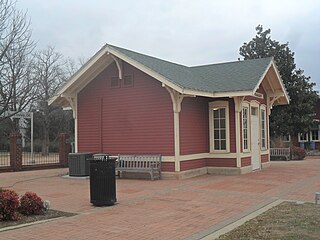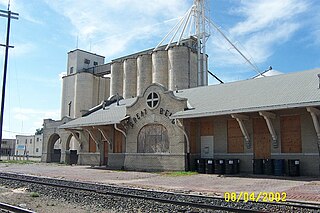
The Atchison, Topeka and Santa Fe Railway, often referred to as the Santa Fe or AT&SF, was one of the largest Class 1 railroads in the United States.

Dearborn Station was, beginning in the late 1800s, one of six intercity train stations serving downtown Chicago, Illinois. It remained in operation until May 1, 1971. Built in 1883, it is located at Dearborn and Polk Streets, to the south of the Loop, adjacent to Printers Row. The station was owned by the Chicago & Western Indiana Railroad, which itself was owned by the companies operating over its line. The station building headhouse now houses office, retail, and entertainment spaces, and its trackage yard, behind the headhouse, was redeveloped into part of the Dearborn Park neighborhood.

The Heartland Flyer is a daily passenger train that follows a 206-mile (332 km) route between Oklahoma City, Oklahoma, and Fort Worth, Texas. It is operated by Amtrak and jointly funded by the states of Oklahoma and Texas.
Oklahoma City is near the geographic center of the United States and is an integral point on the U.S. Interstate Network. The city is served by numerous roads and highways, toll roads, three major airports, a train station, a bus station, and a transit system.

The Lone Star was an Amtrak passenger train that ran between Chicago and Houston, or Dallas via Kansas City, Wichita, Oklahoma City, and Fort Worth. The train was renamed from the Texas Chief, which the Atchison, Topeka and Santa Fe Railway had introduced in 1948. Amtrak discontinued the Lone Star in 1979.

Norman is an Amtrak station in Norman, Oklahoma. The station is serviced by the daily Heartland Flyer, which travels from Fort Worth, Texas to Oklahoma City, Oklahoma. The station building was added to the National Register of Historic Places in 1991 as the Santa Fe Depot.

Oklahoma City Union Depot is a building in Oklahoma City, Oklahoma that served as a "union station" from 1931 until 1967. It was listed on the National Register of Historic Places in 1979. It now houses the offices of the Scissortail Park Foundation.

Ardmore is an Amtrak train station in Ardmore, Oklahoma. The station is serviced by the daily Heartland Flyer, which travels from Oklahoma City, Oklahoma to Fort Worth, Texas.

The San Bernardino Santa Fe Depot is a Mission Revival Style passenger rail terminal in San Bernardino, California, United States. It has been the primary station for the city, serving Amtrak today, and the Santa Fe and Union Pacific Railroads in the past. Until the mid-20th century, the Southern Pacific Railroad had a station 3/4 of a mile away. It currently serves one Amtrak and two Metrolink lines. The depot is a historical landmark listed on the National Register of Historic Places as Atchison, Topeka and Santa Fe Railway Passenger and Freight Depot.

Gainesville, officially the Gainesville Santa Fe Depot, is an Amtrak train station in Gainesville, Texas. The station is serviced by Amtrak's Heartland Flyer route, which travels from Fort Worth, Texas to Oklahoma City, Oklahoma.

Pauls Valley is an Amtrak station in Pauls Valley, Oklahoma. The station is serviced by the daily Heartland Flyer, which travels from Oklahoma City, Oklahoma to Fort Worth, Texas.

Purcell is an Amtrak station in Purcell, Oklahoma. The station is serviced by Amtrak's daily Heartland Flyer, which travels from Oklahoma City, Oklahoma to Fort Worth, Texas.

The Atchison, Topeka and Santa Fe Passenger and Freight Complex is a nationally recognized historic district located in Fort Madison, Iowa, United States. It was listed on the National Register of Historic Places in 1992. At the time of its nomination it contained three resources, all of which are contributing buildings. The buildings were constructed over a 24-year time period, and reflect the styles that were popular when they were built. The facility currently houses a local history museum, and after renovations a portion of it was converted back to a passenger train depot for Amtrak, which opened on December 15, 2021.

The Chicagoan and Kansas Cityan were a pair of American named passenger trains operated by the Atchison, Topeka and Santa Fe Railway. They ran between Chicago, Illinois and Oklahoma City, Oklahoma. The trains were introduced as a Chicago–Wichita service in 1938 and extended to Oklahoma City the next year. A Kansas City–Tulsa connecting train, the Tulsan, was also introduced at that time. The Chicagoan and Kansas Cityan ran until 1968, while the Tulsan ran until 1971.
Atchison, Topeka and Santa Fe Railway Depot, Santa Fe Depot, Santa Fe Passenger Depot, or variations with Railroad or Station or Passenger and/or Freight may refer to any one of many stations of the Atchison, Topeka and Santa Fe Railway. These include :

Guthrie station is a former railway station in Guthrie, Oklahoma. Built in 1903, it saw passenger service until 1979 and is now a restaurant. The building is a contributing resource of the Guthrie Historic District.

Great Bend station was an Atchison, Topeka and Santa Fe Railway station in Great Bend, Kansas. The station was along Santa Fe's main line between Chicago and Los Angeles. It was on the "northern branch" of the main line as it split in Hutchinson, Kansas. It was also served by a line the ran to Garden City, Kansas, travelling through Ness City and Scott City. Both of these lines are now operated by the Kansas and Oklahoma Railroad. The depot was built in a Mission Revival, common for Santa Fe and Southern Pacific stations in the late 19th and early 20th centuries.

The Big Domes were a fleet of streamlined dome cars built by the Budd Company for the Atchison, Topeka and Santa Fe Railway in 1954. Budd built a total of 14 cars in two batches. The Santa Fe operated all 14 on various streamlined trains until it conveyed its passenger trains to Amtrak in 1971. The Santa Fe retained one as a business car and sold the remaining 13 to the Auto-Train Corporation, which operated them for another ten years. All but two have been preserved in varying condition.

Gulf, Colorado and Santa Fe Railroad Passenger Station is a former passenger train station in Fort Worth, Texas. From 1971 to 2002, it was used as Fort Worth's Amtrak station.
The Eastern Flyer was a proposed medium distance inter-city train traveling between Oklahoma City in central Oklahoma and Tulsa in north-eastern Oklahoma. It was originally planned to be a private operation by the Iowa Pacific Railroad, and its services were to have included a dome car, coaches and full meal service. This would have been the first regular passenger service to Tulsa since the Santa Fe discontinued service in 1971.


















